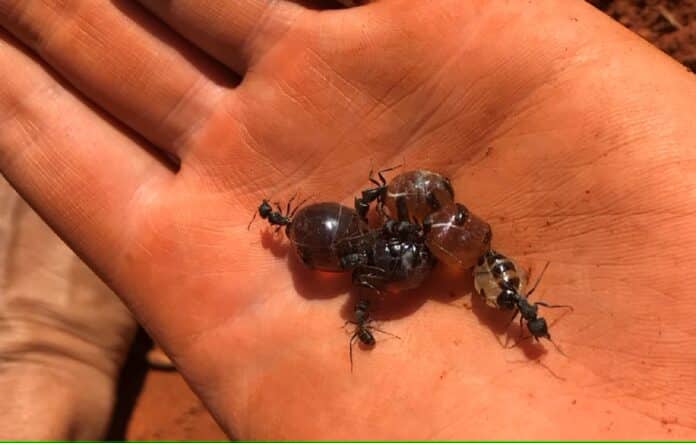Honey produced by the Australian honeypot ant (Camponotus inflatus) is valued nutritionally and medicinally by Indigenous peoples, but its antimicrobial activity has never been formally studied. A new study determined the activity of honeypot ant honey (HPAH) against a panel of bacterial and fungal pathogens, investigated its chemical properties, and profile the bacterial and fungal microbiome of the honeypot ant for the first time.
Scientists from the University of Sydney have found that the honey made by Australian ants has distinct anti-microbial properties against bacteria and fungi, which could make the substance beneficial as a medication.
Scientists, in particular, studied the Australian honeypot ant, Camponotus inflatus. The ant is usually found throughout desert areas, mainly in Western Australia and the Northern Territory.
As a rare source of natural sugar in an arid environment, honeypot ants are stuffed with nectar and sugary substances by other worker ants, causing their abdomens to inflate with honey and have a translucent, amber appearance. When other food sources are limited, these ants become immobile vending machines for their colony, regurgitating honey.
Mr. Danny Ulrich from the Tjupan language group, who runs honeypot ant tours in Kalgoorlie, helped the researchers track down specimens for their study. He stated, “For our people, honey ants are more than just a food source. Digging for them is a very enjoyable way of life and bringing the family together.”
“As for its medicinal use, we use it for sore throats and sometimes as a topical ointment to help keep infections at bay.”
Scientists noted, “The study marks the first time that ant honey has been investigated for its medicinal properties.”
Mr. Andrew Dong from the University of Sydney’s Carter Lab said, “I have long been fascinated by the honeypot ant and its amazing way of producing and storing honey. Given the medicinal use of the honey by Indigenous people, I wondered if it might have unique antimicrobial characteristics.”
Scientists have confirmed that ant honey has markedly different antimicrobial activity and chemical properties, suggesting HPAH has a unique mode of antimicrobial action compared to Manuka honey, which is well-established as a topical treatment for wounds and skin infections.
Dr. Kenya Fernandes from the University of Sydney’s Carter Lab said, “Our research shows that honeypot ant honey possesses a distinctive effect that sets it apart from other types of honey. This discovery means that honeypot ant honey could contain compounds with substantial antimicrobial power; identifying these could provide us with starting points for developing new and different types of antibiotics.”
The researchers found the ant’s honey is effective against Staphylococcus aureus, a bacterium commonly known as golden staph. They also found ant honey is potent against two species of fungi, Aspergillus and Cryptococcus.
Journal Reference:
- Dong AZ, Cokcetin N, Carter DA, Fernandes KE. 2023. Unique antimicrobial activity in honey from the Australian honeypot ant (Camponotus inflatus) PeerJ 11:e15645 DOI: 10.7717/peerj.15645
